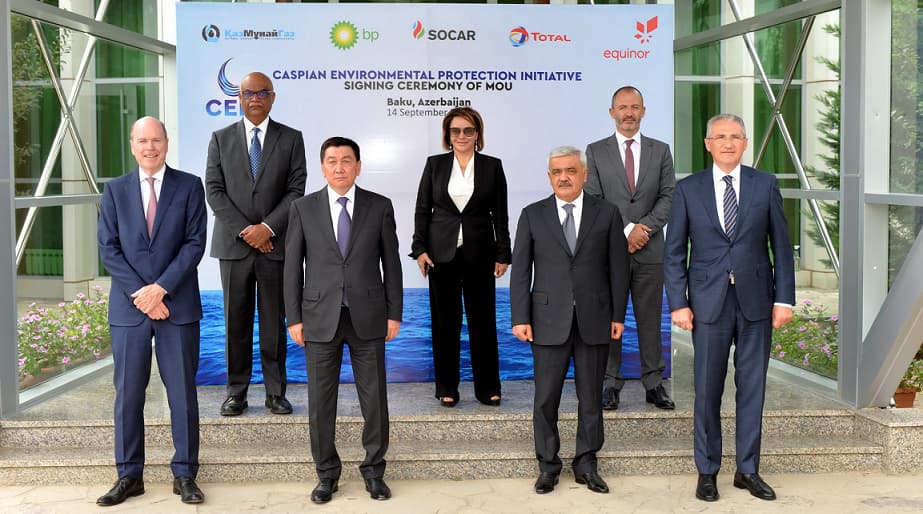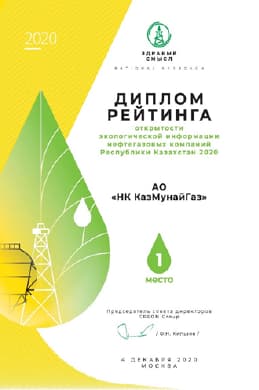Environmental responsibility and safety
| Year | SOX emissions intensity | NOX emissions intensity | APG flaring rate | APG utilisation rate, % |
|---|---|---|---|---|
| 2016 | 0.39 | 0.24 | 12 | 86 |
| 2017 | 0.32 | 0.25 | 11 | 85 |
| 2018 | 0.25 | 0.20 | 6 | 93 |
| 2019 | 0.20 | 0.21 | 2.95 | 97 |
| 2020 | 0.23 | 0.22 | 2.2 | 98 |

The Company’s goals in HSE management are directly related to its Development Strategy. KMG’s Development Strategy until 2028 (the Strategy) covers strategic initiatives to promote greater environmental responsibility. The Company’s environmental priorities include management of greenhouse gas emissions, water resources and production waste, flaring reduction, land reclamation, and energy efficiency improvement.
In line with the Strategy priorities, its HSE Policy was divided into separate policies: the Occupational Health and Safety Policy and the Environmental Policy which were approved by the Board of Directors in 2020. Management teams at KMG and its subsidiaries and associates take a zero tolerance approach to losses and harm caused by environmental pollution.
In 2015, KMG supported the World Bank’s Zero Routine Flaring by 2030 initiative. KMG’s Emissions Management Policy was approved in 2019 as part of this initiative. The Policy is aimed at complete elimination of routine flaring and is comprised of eight key principles, six of which directly address climate change.
The first Corporate Environmental Impact Assessment Standard was developed and approved in 2020 as part of KMG Group’s Health, Safety and Environmental Management Guidance. The Standard defines the Company’s principles for assessing the environmental impact of planned activities and regulates the activities of KMG Group, its employees and contractors, including engineering and design organisations involved in the development of technical documents and materials of environmental impact assessment, surveying and documenting public opinion on environmental impact assessment materials as well as obtaining emission permits.
As a result of its efforts to improve environmental performance and ensure openness and transparency in this area, KMG has topped, for the fourth consecutive year, the Environmental Transparency Rating of Oil and Gas Companies compiled by independent experts from WWF Russia, the National Rating Agency, and CREON Group.
The rating methodology was tested for corporate use, and KMG subsidiaries and associates have been rated internally for the second year running, with Intergas Central Asia topping the rating and followed by JSC Embamunaigas and KazTransOil.
KMG remains committed to being an environmentally responsible business, further enhancing its environmental protection management system, maintaining dialogue with all stakeholders on this matter, and thus delivering on its commitments as stated in the Company’s Environmental Policy.
On 14 September 2020, in Baku, KazMunayGas signed a memorandum of understanding with the State Oil Company of the Azerbaijan Republic, BP Exploration (Caspian Sea) Limited, Equinor Apsheron AS, and TOTAL E&P Absheron B.V. The Memorandum stipulates the establishment of the Caspian Environmental Protection Initiative (CEPI). As declared, the main goals of the Initiative are the establishment of the first platform to protect the environment and conduct joint research by international oil companies operating in the region. The participating companies will take active joint efforts to address climate change threatening the sustainability of the Caspian region and prevent the emissions of greenhouse gases and hazardous substances into the environment. In addition, cooperation under CEPI implies researching and promoting best practice, standards and technologies in environmental protection, developing and implementing joint preventive measures to fight climate change, arranging awareness-raising and advocacy campaigns, involving regional stakeholders and regulators in addressing environmental protection, and pursuing other efforts.

